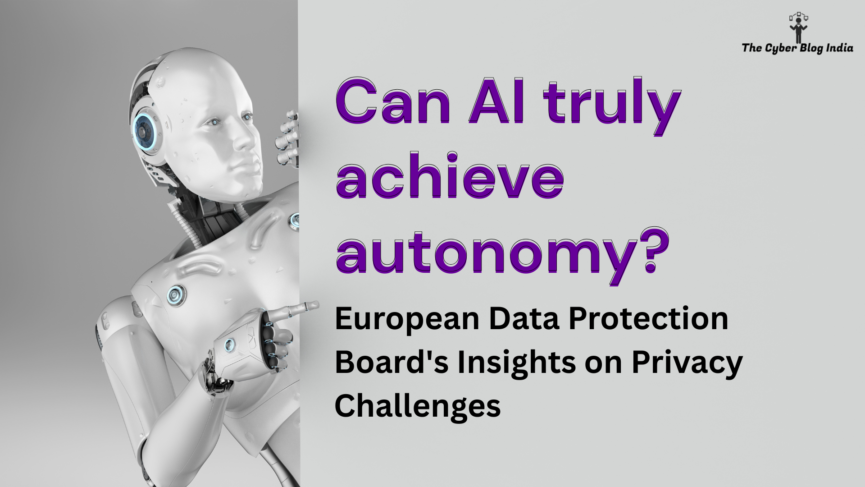Can AI truly achieve anonymity? EDPB’s Insights on Privacy Challenges

The use of Artificial Intelligence (AI) has become essential in our daily lives. It is driving innovation and changing industries with generative AI and predictive models. However, as these technologies develop, we also need to address issues and concerns that come along with them. One such question is: is it possible for AI to be completely anonymous? Moreover, while training AI models on personal data, what does anonymity truly mean? In one of its recent opinions, the European Data Protection Board (EDPB) addressed these issues and clarified the privacy concerns associated with AI. The Board’s observations offer a road map for overcoming difficulties associated with data security in AI. But what does this mean on a global scale, especially in a country like India that is digitalising its infrastructure quickly?
Can AI really be autonomous?
At first glance, the concept of anonymity may appear simple. Just take away personal information, right? Not quite. The EDPB claims that designating AI models as “anonymous” is neither simple nor automated. To ensure that an AI model satisfies the stringent anonymity requirements set forth in the GDPR, a thorough case-by-case analysis is necessary. Moreover, an AI model must pose negligible danger of unintentionally or purposely disclosing personal information in order to be considered truly anonymous. This involves assessing situations in which the model might unintentionally reveal private data. A model is not anonymous if there is any possibility of identifying specific individuals.
The Accountability Factor
The onus of proof is on the business claiming that its AI model is anonymous. They must provide thorough documentation of how their model was able to remain anonymous. In the absence of adequate proof, Supervisory Authorities (SAs) can conclude that they have violated their GDPR responsibilities. This could result in additional inquiries and possible sanctions. This emphasises how crucial accountability and openness are to the advancement of AI. Saying that a model is anonymous is insufficient, organisations need to be prepared to provide evidence.
Development and Deployment: Distinct Phases, Distinct Regulations
However, the fascinating twist is that under the GDPR, the creation (training) and application (use) of AI models are considered as distinct data processing activities. This implies that problems involving private information during training do not always render the deployment stage incorrect. But each step must adhere to the GDPR requirements on its own. Organisations must evaluate risks during deployment and ensure proper handling of personal data. More thorough reviews are necessary for higher risks.
Why is AI Anonymity so difficult?
Point it, it takes more than just eliminating recognisable identifies like names or addresses to achieve anonymity in AI. True anonymity, according to the EDPB, requires that there be a very chance of identifying a person, even indirectly. This calls for assessing several factors:
- Risk Scenarios: Is it possible that the model will unintentionally divulge personal information?
- Data Traceability: Can the data be traced back to specific people using any patterns or conclusions?
- Documentation: Is it possible for the organisation to provide compelling proof that they have used strong anonymisation methods?
Consequently, failure to address these factors could undermine the integrity of AI systems. Moreover, organisations frequently underestimate the stakes. An AI system may face inquiries, penalties, or harm to its reputation if it does not adhere to the strict anonymity requirements of the GDPR. Even with AI, businesses are now responsible for making data protection a top priority rather than an afterthought.
Garante’s historic decision against OpenAI
Recently, Garante per la protezione dei dati personali (the Italian Data Protection Authority) imposed a fine of €15 million on OpenAI for violating GDPR regulations pertaining to data gathering, transparency, and age verification. The Italian regulator also banned OpenAI in the country. In response, OpenAI launched a six-month public campaign on dta practices and implemented safeguards such as age-verification system and transparent explanations of data usage. Eventually, the authority lifted off the ban. This decision emphasises how important it is for an AI system to be transparent, accountable, and user-safe.
India’s situation: Data security in a developing AI environment
While the Indian Parliament has passed the Digital Personal Data Protection Act, 2023, the actual date of implementation is not out yet. Moreover, it does not have the level of granularity seen in the GDPR, the Indian law emphasises on accountability, transparency, and purpose limitation in data processing. These principles align closely with the GDPR. However, the challenge for Indian businesses lies in interpreting these principles in the context of AI. Many organisations lack the expertise or infrastructure to implement advanced anonymisation techniques. The EDPB’s insights could serve as a valuable reference point for developing compliance strategies in India.
In some cases, AI can pose risks for India due to enormous population and varied data collection. AI programs that would be trained on such data may inadvertently reveal details about vulnerable populations. Biases in AI models used for applications such as medical diagnosis or loan approvals may provide discriminating results. This emphasises how crucial it is to incorporate privacy-by-design principles.
As the country move towards a tech-driven economy, it is necessary to strike a balance between privacy and innovation. The EDPB’s strategy underlines the necessity of gicing long-term trust precedent over immediate benefits. In a globalised world, privacy is not just a legal requirement but also a competitive advantage that both the startups and tech behemoths most acknowledge. To strike a balance, government and authorities are working on AI governance frameworks and the EU’s AI Act is one such example. An AI-specific regulatory framework is still in its infancy in India, notwithstanding the NITI Aayog’s “AI for All” plan A strong governance framework might help close the gap between accountability and creativity.
Conclusion
This is no doubt that AI can completely transform the society, but only if it is based on openness and trust. True anonymity in AI is difficult to obtain but not impossible with the correct steps, diligence, and accountability, as the EDPB’s opinion reminds us. While businesses rush to innovate, they must not forget their data protection obligations under the relevant laws. Hence, responsible innovvation is to key to AI’s bright future.
